
Sir George Gilbert Scott, largely known as Sir Gilbert Scott, was a prolific English Gothic Revival architect, chiefly associated with the design, building and renovation of churches and cathedrals, although he started his career as a leading designer of workhouses. Over 800 buildings were designed or altered by him.
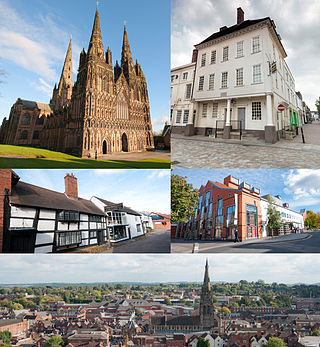
Lichfield is a cathedral city and civil parish in Staffordshire, England. Lichfield is situated 18 miles (29 km) south-east of Stafford, 9 miles (14 km) north-east of Walsall, 8 miles (13 km) north-west of Tamworth and 13 miles (21 km) south-west of Burton Upon Trent. At the time of the 2021 Census, the population was 34,738 and the population of the wider Lichfield District was 106,400.
John Bell was a Bishop of Worcester (1539–1543), who served during the reign of Henry VIII of England.

Sir Joseph Edgar Boehm, 1st Baronet, was an Austrian-born British medallist and sculptor, best known for the "Jubilee head" of Queen Victoria on coinage, and the statue of the Duke of Wellington at Hyde Park Corner. During his career Boehm maintained a large studio in London and produced a significant volume of public works and private commissions. A speciality of Boehm's was the portrait bust; there are many examples of these in the National Portrait Gallery. He was often commissioned by the Royal Family and members of the aristocracy to make sculptures for their parks and gardens. His works were many, and he exhibited 123 of them at the Royal Academy from 1862 to his death in 1890.
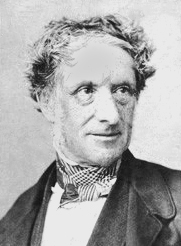
Sir Richard Westmacott was a British sculptor.
Basil Champneys was an English architect and author whose most notable buildings include Manchester's John Rylands Library, Somerville College Library (Oxford), Newnham College, Cambridge, Lady Margaret Hall, Oxford, Mansfield College, Oxford and Oriel College, Oxford's Rhodes Building.
The Bishop of Lichfield is the ordinary of the Church of England Diocese of Lichfield in the Province of Canterbury. The diocese covers 4,516 km2 of the counties of Powys, Staffordshire, Shropshire, Warwickshire and West Midlands. The bishop's seat is located in the Cathedral Church of the Blessed Virgin Mary and Saint Chad in the city of Lichfield. The Bishop's residence is the Bishop's House, Lichfield, in the cathedral close. In the past, the title has had various forms. The current bishop is Michael Ipgrave, following the confirmation of his election on 10 June 2016.
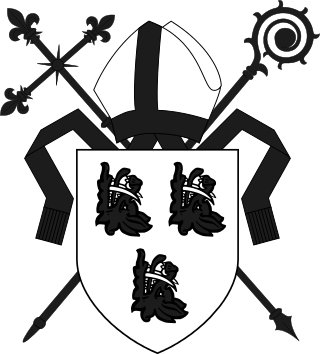
Lawrence Booth served as bishop of Durham and lord chancellor of England, before being appointed archbishop of York.

Frederick Cornwallis was a British clergy member who served as Archbishop of Canterbury after a career in the Church of England. He was born the seventh son of an aristocratic family.

Charles Eamer Kempe was a British Victorian era designer and manufacturer of stained glass. His studios produced over 4,000 windows and also designs for altars and altar frontals, furniture and furnishings, lychgates and memorials that helped to define a later nineteenth-century Anglican style. The list of English cathedrals containing examples of his work includes: Chester, Gloucester, Hereford, Lichfield, Wells, Winchester and York. Kempe's networks of patrons and influence stretched from the Royal Family and the Church of England hierarchy to the literary and artistic beau monde.

Francis Bird (1667–1731) was one of the leading English sculptors of his time. He is mainly remembered for sculptures in Westminster Abbey and St Paul's Cathedral. He carved a tomb for the dramatist William Congreve in Westminster Abbey and sculptures of the apostles and evangelists on the exterior of St Paul's, a memorial to William Hewer in the interior of St Paul's Church, Clapham as well as the statue of Henry VI in School Yard, Eton College. Despite his success, later in life Bird did little sculpting. He had inherited money from his father-in-law and set up a marble import business.

English Gothic is an architectural style that flourished from the late 12th until the mid-17th century. The style was most prominently used in the construction of cathedrals and churches. Gothic architecture's defining features are pointed arches, rib vaults, buttresses, and extensive use of stained glass. Combined, these features allowed the creation of buildings of unprecedented height and grandeur, filled with light from large stained glass windows. Important examples include Westminster Abbey, Canterbury Cathedral and Salisbury Cathedral. The Gothic style endured in England much longer than in Continental Europe.
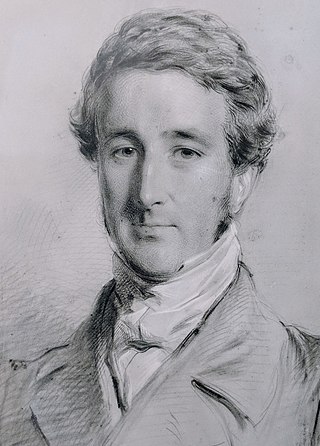
Charles John Abraham was the first Anglican Bishop of Wellington. He married Caroline Palmer who became a noted artist.

Alfred Edward John Rawlinson was an eminent British scholar of divinity and an Anglican bishop. He was the second Bishop of Derby from 1936 until his retirement in 1959.
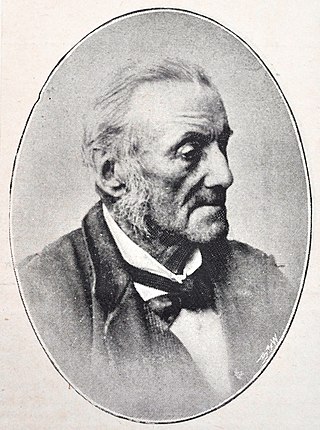
Francis Alfred Skidmore was a British metalworker best known for high-profile commissions, including the glass and metal roof of the Oxford University Museum of Natural History (1859), the Hereford Cathedral choir screen (1862) and the Albert Memorial (1866–73) in London. Skidmore was heavily influenced by Gothic Revival style, a movement characterised by its use of medieval designs and styles. He was a member of both the Oxford Architectural Society and the Ecclesiological Society, two organisations which endorsed the Gothic Revival style. Skidmore also worked closely with architect Sir George Gilbert Scott.
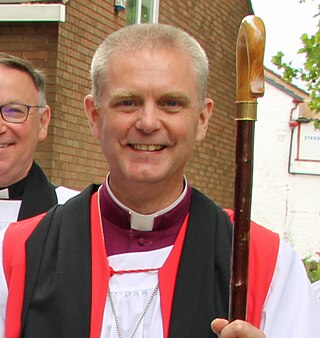
The Bishop of Chester is the Ordinary of the Church of England Diocese of Chester in the Province of York.

William Weldon Champneys was an Anglican priest and author in the 19th century. He served as Dean of Lichfield from 1868 until his death.
Charles Buckeridge was an English churchman, Archdeacon of Coventry from 14 March 1816 until his death.
Paul Richard Thomas SSC is a British Anglican bishop who has served as Bishop of Oswestry, a suffragan bishop in the Diocese of Lichfield and the provincial episcopal visitor for the western half of the Province of Canterbury since February 2023. From 2011, he was vicar of St James's Church, Paddington.
Peter Walker is a British sculptor and artist who works in public art, monumental bronze and other materials, fine and installation art... His work consists of large-scale sculpture, commissioned and bespoke sculptural works, paintings, drawings and large-scale installations. Walker is a fellow of the Royal Society of British Artists, and a member of the Royal Society of Sculptors.













